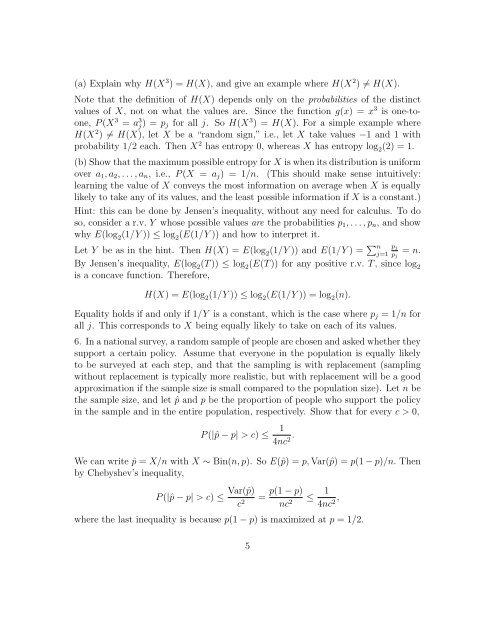Strategic Practice and Homework 10 - Projects at Harvard
Strategic Practice and Homework 10 - Projects at Harvard
Strategic Practice and Homework 10 - Projects at Harvard
- No tags were found...
You also want an ePaper? Increase the reach of your titles
YUMPU automatically turns print PDFs into web optimized ePapers that Google loves.
(a) Explain why H(X 3 )=H(X), <strong>and</strong> give an example where H(X 2 ) 6= H(X).Note th<strong>at</strong> the definition of H(X) dependsonlyontheprobabilities of the distinctvalues of X, notonwh<strong>at</strong>thevaluesare. Sincethefunctiong(x) =x 3 is one-toone,P (X 3 = a 3 j)=p j for all j. So H(X 3 )=H(X). For a simple example whereH(X 2 ) 6= H(X), let X be a “r<strong>and</strong>om sign,” i.e., let X take values 1<strong>and</strong>1withprobability 1/2 each.ThenX 2 has entropy 0, whereas X has entropy log 2 (2) = 1.(b) Show th<strong>at</strong> the maximum possible entropy for X is when its distribution is uniformover a 1 ,a 2 ,...,a n ,i.e.,P (X = a j )=1/n. (This should make sense intuitively:learning the value of X conveys the most inform<strong>at</strong>ion on average when X is equallylikely to take any of its values, <strong>and</strong> the least possible inform<strong>at</strong>ion if X is a constant.)Hint: this can be done by Jensen’s inequality, without any need for calculus. To doso, consider a r.v. Y whose possible values are the probabilities p 1 ,...,p n ,<strong>and</strong>showwhy E(log 2 (1/Y )) apple log 2 (E(1/Y )) <strong>and</strong> how to interpret it.Let Y be as in the hint. Then H(X) =E(log 2 (1/Y )) <strong>and</strong> E(1/Y )= P n p jj=1 p j= n.By Jensen’s inequality, E(log 2 (T )) apple log 2 (E(T )) for any positive r.v. T ,sincelog 2is a concave function. Therefore,H(X) =E(log 2 (1/Y )) apple log 2 (E(1/Y )) = log 2 (n).Equality holds if <strong>and</strong> only if 1/Y is a constant, which is the case where p j =1/n forall j. ThiscorrespondstoX being equally likely to take on each of its values.6. In a n<strong>at</strong>ional survey, a r<strong>and</strong>om sample of people are chosen <strong>and</strong> asked whether theysupport a certain policy. Assume th<strong>at</strong> everyone in the popul<strong>at</strong>ion is equally likelyto be surveyed <strong>at</strong> each step, <strong>and</strong> th<strong>at</strong> the sampling is with replacement (samplingwithout replacement is typically more realistic, but with replacement will be a goodapproxim<strong>at</strong>ion if the sample size is small compared to the popul<strong>at</strong>ion size). Let n bethe sample size, <strong>and</strong> let ˆp <strong>and</strong> p be the proportion of people who support the policyin the sample <strong>and</strong> in the entire popul<strong>at</strong>ion, respectively. Show th<strong>at</strong> for every c>0,P (|ˆp p| >c) apple 14nc 2 .We can write ˆp = X/n with X ⇠ Bin(n, p). So E(ˆp) =p, Var(ˆp) =p(1by Chebyshev’s inequality,P (|ˆpp| >c) apple Var(ˆp)c 2 =p(1 p)nc 2 apple 14nc 2 ,where the last inequality is because p(1 p) ismaximized<strong>at</strong>p =1/2.p)/n. Then5
















